|
中国正在完成从素质教育到应试教育的转变,现在的课堂正在以培养学生的综合能力为主进行英语教学,这就要求英语老师改变过时的教学方法,提高课堂效率。根据国家英语课程,教师的目标、教学过程、评估程序以及教学资源的发展的要求来看,都应该反映出以学生为中心的教学原则。课堂教学过程应该成为老师指导学生,而学生自己探索,实际上,英语课堂是一个交互式的语言活动。近年来,许多研究已经证明了语言类的交互是关键。学生和教师之间的交互的主要部分是语言交互。许多学者和研究人员深入研究和证明了教师的教育方法至关重要,我们应该关注学生参与的内容,鼓励参与,增加课堂互动。有效的提问可以作为教师和学生之间的桥梁。它有助于建立它们之间的关系。如今在中国,质疑(课堂提问)策略被广泛使用,尤其是在英语课中。 1 Background背景 1.1 Research background As education in China is changing from exam-oriented education to quality education, to cultivate students’ comprehensive ability of using language gradually becomes the purpose of English teaching. This requires English teachers to change the outdated teaching methods to improve the efficiency in the classroom. According to the National English Curriculum, teachers’ objectives, teaching processes, assessment procedures as well as the development of teaching resources should all reflect the principle of learner-centered approach. Classroom teaching should become the process during which students are guided by the teachers. Actually, English classroom is an interactive language activity. In recent years, many researches have proved interaction is the key of language class. The interaction between students and teachers is the main part of the class interaction. And asking questions in class is an important means of communication between teachers and students. Many scholars and researchers have made thorough researches and proved questioning is crucial to the way teachers manage the class, engage students with content, encourage participation and increase classroom interaction. Effective questioning can be used as a bridge between teachers and students. It is helpful to build up the relationship between them. Nowadays in China, questioning strategies have been widely used, especially in English classes. 1.1.1 What is questioning? In the Longman Dictionary of the English Language, the definition of a question is the command or interrogative expression used to elicit information or a response, or to test knowledge. Wragg (1984) gives his definition in Classroom Teaching Skills: “In classroom settings, questioning is defined as any behavior which can initiate verbal response.” So questioning in the classroom is acted as a tool to impart knowledge, and serves as a crucial source of input as well. 1.1.2 Classroom interaction Allwright (1984) regards teaching in the classroom as an interactive process. Actually, any classroom activities contain the interaction of language, even the form-focused instruction. Learners could regard it as a way to input language. Classroom interaction promotes the acquisition of second language in two ways: (1) learners’ exposure to the second language; (2) learners’ attempt to use the second language (Ellis, 1990). And questioning is a good way for teachers to interact with students. So if we want to investigate the questioning strategies, first of all, we should understand the relationship between interaction and language acquisition. In Krashen’s (1985) “input hypothesis” theory, the understanding of input language is the basic way to acquire language. Only when learners get the comprehensible input, can they acquire the target language. So the most important method of language teaching is to input more comprehensible knowledge to learners. As the main part of teachers’ utterance, classroom questioning provides an important source for comprehensible language input. Long (1983) confirms the importance of comprehensible language input in language acquisition. Meanwhile, he particularly emphasizes the promotion of meaningful negotiation. He holds the opinion that two-way communication is more advantageous than one-way communication for language acquisition. In two-way communication, when one side could not understand the other side, he has the chance to inform the other side. When the two sides negotiate the meaning and modify the interaction, the comprehensible language input is increased. In Swain’s (1985) “output hypothesis”, he states that on the basis of comprehensible input, learners should get the chance to output their language to reach the goal of communication. If learners’ output is accurate, coherent and appropriate during the meaningful negotiation, it will help learners enrich the essential grammar knowledge. Besides, language output provides chances for learners to check whether their hypothesis on the target language is true or false. Moreover, when understanding the information, usually learners need not to analyze the sentence structures of the input language. However, output compels learners to pay attention to the language forms when expressing the meaning. Based on the above theories, questioning achieves the teaching goals through the process of input, interaction and output, and thus helps learners acquire second language more easily and quickly. 1.2 Purpose of study Language teaching has a particular feature, which is language is not only the teaching method, but also the teaching content. So it demands more on language teachers. Besides grasping the target language skillfully, they should also realize how to teach language through using language, and how to make students grasp the language through using it. In most western countries, most second language teachers are the native speakers of the target language with pedagogic or applied linguistic master's degree. While in China, most Chinese students learn English in English classes, and most teachers are Chinese people. Though they have obtained the pedagogic or applied linguistic bachelor's degree, master's degree, or even doctor's degree, they are just high-level foreign language learners. Gao Yihong (1999) makes an investigation into domestic English teachers who have attended the national even international academic conferences, and the result shows that only 18.5 percent of them have learned applied linguistic systematically, half of them have certain understanding of applied linguistic, and one-third of them know little about applied linguistic. Also, the result of Dai Weidong's (2001) questionnaire indicates that the quality and professional skills of English teachers in our country are not optimistic. In general, because of different views of language and education, and different cultural background, there are some differences between Chinese teachers and foreign teachers when adopting questioning strategies in English classes. The purpose of this paper is to perfect English teaching in China through the comparison and analysis between the English teachers of China and English-speaking countries. 2 Literature Review文献综述 Large amounts of researches have been made on questioning at home and abroad. This section is a brief literature review focus on the previous studies of the significance of classroom questioning and some major questioning strategies. 2.1.3 Significance of classroom questioning Because the employment of questioning by teachers and students in classes is closely related to the accomplishment of educational goals, questioning is considered to be an important method of learning and instruction. Large numbers of educational researchers find broad educational benefits which can be gained by using the effective questioning. The points of foreign researchers’ agreement include; (1) Questioning can develop higher level thinking (Sander, 1966); (2) Questioning can help motivate students (Hunkins, 1972); (3) Questioning can improve learning from text (Weaver, 1978); (4) Questioning can aid in planning lessons (Hill, 1979); (5) Questioning can help verify the learning process (Hyman, 1979). Besides foreign researchers, domestic scholars have also made thorough investigations into teaching process and have found certain benefits of questioning. Liu Lili and Liu Shuiqing (2009) summarize the functions of questioning from their teaching experience as follows: (1) Questioning helps motivate students’ learning interest and provide psychological needs. (2) Questioning, which is dynamic interaction, can strengthen students' memory of the important language. (3) Questioning helps teachers prepare for the lessons more earnestly. (4) Questioning helps improve the interaction of teaching and live up the class. 2.1.4 Previous researches on questioning strategies As questioning benefits so much in teaching and learning, teachers should adopt the questioning strategies effectively. However, this has always been a big problem for teachers. Based on previous theories, many experts make numerous researches into questioning strategies, and most of them are focused on question classification, wait time, distribution of students who answer the questions, and feedback.#p#分页标题#e# Many questioning strategies are built on question classification systems. At least 11 question classification systems are proposed in the 1960's. The most well-known classification system is put forward by Sanders (1966). His question categories are based on the levels of Bloom's Taxonomy. These levels are: memory, translation, interpretation, application, analysis, synthesis, and evaluation. Memory is the lowest level question while evaluation is the highest. And Sanders reasons that higher level questions would stimulate the development of learners' cognitive abilities. He recommends teachers to use many different types of questions to insure a "varied intellectual atmosphere in the classroom." In Davis and Tinsley's (1967) study, they find that the most frequently asked questions by teachers are memory, interpretation. While evaluation, synthesis, analysis, application and translation questions are asked relatively infrequently. Perrott (1982) and Jacobsen (1999) both propose four questioning strategies: self-explaining, prompting, probing and redirecting. Usually teachers use self-explaining before asking questions in order to let students understand the questions. When students do not know how to answer the questions, teachers will use prompting to help them. When students provide correct but uncompleted answers, teachers will use probing to encourage students to supply more information. Redirecting means "the same question is directed to several students". His classification is based on students' response, and he recommends teachers should make adjustments in their questioning techniques when communicating with students. Long and Sato (1983) classify the questions into two types: referential questions and display questions. Referential questions are those questions for which the answer is not already known by the teacher. Theses questions require interpretation and judgment on the part of the "answerer". Display questions are those questions for which the questioner knows the answer beforehand. These types of questions are usually asked for comprehension, confirmation or clarification. They recommend teachers should raise more referential questions which can develop students' higher level thinking, however, they find that in real classroom, display questions occupies 79% of all questions. This result shows that actually teachers do not follow experts' advice, and the interaction using target language is only a small part of the class. Wait time refers to the amount of time teachers wait after raising questions and before students providing answers. In an investigation of primary science class, Mary Budd Rowe (1986) finds that wait time the teacher allows students to think is less than 2 seconds. This is too short for average learner to complete the four mental steps required to answer a question (Bond, 2008). At first, students hear the question and decide whether they understand it. Then, they recall the information from their memories. Third, they consider if their responses will be accepted, and finally, they decide whether the teacher will praise or rebuke their responses. Bond also indicates that if teachers increase the amount of wait time, the length of the response will increase, and the failures to respond will decrease. Distribution of students means the chance teachers give to every student. And from Nunan's (1990) investigation, teachers usually call the students who sit at the front and in the middle of the classroom to answer the questions. If students think teachers do not treat them equally, their classroom participation will decrease, therefore teaching efficiency will be influenced. Feedback means teachers' responses towards students' answers. After a detailed analysis of a secondary English class, Cullen (2002) indicates that teachers' feedback has two functions: evaluation function and discourse function. The evaluation feedback means teachers decide whether students give the right answer. Unlike evaluation feedback, discourse feedback pays more attention to the content of students' answer, rather than the language itself. In order to increase the efficiency of language classes, numerous educational literatures provide advice for asking questions. Among them, Bond (2008) highlights some of the techniques mentioned in the literature and offers additional strategies: (1) write out some questions when planning the lesson; (2) establish your expectations for behavior before beginning the questioning period; (3) call on a variety of students; (4) cue students before asking the question; (5) ask questions that are the appropriate level for each student; (6) ask questions that elicit positive or correct response; (7) provide students with sufficient wait time after asking a question and before responding to their comments; (8) vary the way students respond to questions; (9) vary the person who responds to the questions; (10) respond to every answer and correct errors; (11) ask follow-up questions; (12) encourage students to ask questions. 3 Research Design研究设计 3.1.1 Data collection The purpose of this study is to compare the questioning strategies in English classes between Chinese teachers and foreign teachers, so we adopt natural inquiry method. In order to reflect the classroom truthfully, classroom recording and questionnaire are used. 3.1.2 Classroom recording The subject of my classroom recording is a foreign English teacher and a Chinese English teacher from Ningbo Foreign Language School. Both of them have abundant teaching experience. Without noticing them, we record one of their English classes separately, and then transcribe the recording material and analyze the data. 3.2.1 Questionnaire Considering the occasionality and the one-sidedness of classroom recording, questionnaire is used as another tool of investigation. The subject of our questionnaire (see Appendix) is the students of Senior 1 and Senior 2 from Ningbo Foreign Language School. A total of 120 questionnaires are dispatched, and 112 replies are returned, 105 of which are valid. The questionnaire is consisted of four parts: the background information of students, the current situation of Chinese English teachers and foreign English teachers’ questioning, students’ reflection and hope, and an open question. The most important part is the second part. We focus on teachers’ talking time, types of teachers’ questions, wait time, feedback and so on. Because our subject is senior one and senior two students, who have learnt English at least seven years. They have been familiar with their teachers’ questioning strategies and have already sensed the effects classroom questioning brings. In the third part of our questionnaire, we want to figure out whether they like English classes and what do they expect the teachers to do when they are answering the questions, and how teachers help them when they can not give the answers, or even give a wrong answer. The last one is an open question about students’ proposals for classroom questioning to their Chinese English teachers or foreign English teachers 3.2.2 Data processing In dealing with the data of recording material, first, we transcribe the recording material into written material, second the questioning sections are highlighted, third we calculate the amount of time separately according to the elements about questioning strategies like types, wait time, feedback, and at last we figure out the percentage with the help of calculator. When processing the questionnaire data, in the first place, we sort out the data of each choice under each item, and then calculate the percentage. The results are showed in the way of statistical table respectively, so as the results of recording material. When analyzing the data, we will compare the data both form recording material and questionnaire to make the result more accurate and reliable. 4 Data Analysis and Discussion数据分析与讨论 This part is dedicated to presenting the data collected from classroom recording and questionnaire, and discussing the main questioning strategies that teachers adopt, including the following four aspects: allocation strategies, types of questions, wait time and feedback. 4.2.3 Allocation strategies Here allocation means how teachers arrange their talking time and the amount of time used to raise questions. According to the recording material, the amounts of teachers’ talking tine and students’ talking time are showed in Table 1: Table 1: The Amount of Talking Time 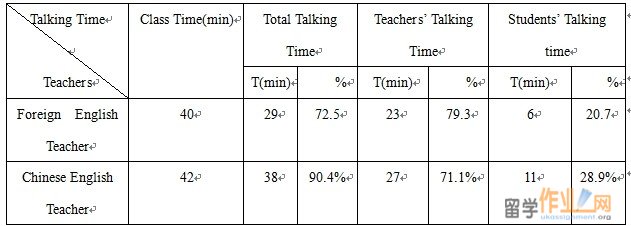 Teachers Class Time(min) Total Talking Time Teachers’ Talking Time Students’ Talking time T(min) % T(min) % T(min) % Foreign English Teacher 40 29 72.5 23 79.3 6 20.7 Chinese English Teacher 42 38 90.4% 27 71.1% 11 28.9% Table 2: The Amount of Talking Time 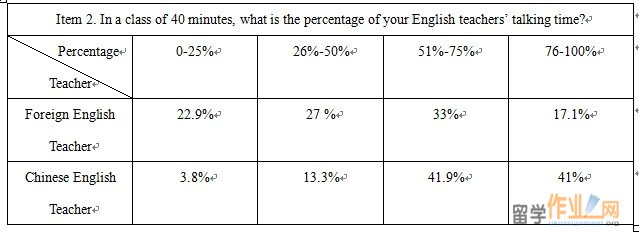 #p#分页标题#e# #p#分页标题#e#Item 2. In a class of 40 minutes, what is the percentage of your English teachers’ talking time? Teacher 0-25% 26%-50% 51%-75% 76-100% Foreign English Teacher 22.9% 27 % 33% 17.1% Chinese English Teacher 3.8% 13.3% 41.9% 41% Table 3: The Amount of Questioning Time  Teacher Teachers’ Talking Time Questioning Time T(s) T(s) % Foreign English Teacher 1380 577 41.8% Chinese English Teacher 1420 632 44.5% Table 4: The Amount of Questioning Time  Item 3: In their taking time, how much time will your teachers spend in questioning? Teacher 0-33% 33%-66% 66%-100% Foreign English Teacher 23.8% 49.5% 26.7% Chinese English Teacher 36.2%% 52.4% 11.4% From Table 1, we can see in Chinese English teacher’s class, the proportion of teacher’s talking time is 71.1%, while the percentage of students’ talking time is 28.9%. In foreign English teacher’s class, the proportion of teacher’s talking time is 79.3%, and the percentage of students’ talk is 20.7%. They almost control four-fifths of the total talking time. What’s more, as it showed in the results of questionnaire (Table 2), most students consider they share almost the same talking time with their foreign English teachers. On the contrary, nearly 83% students consider that in Chinese Teachers’ English classes, they talk rather less than their teachers. As for the allocation of questioning time, both of them spend nearly half of their talking time on questioning. We can discover this both from the recording material (Table 3) and the questionnaire (Table 4). It indicates that English teachers have realized the significance of questioning and it has become one of the common techniques used in English teaching. Swain (1985) confirms the importance of comprehensible language input in the language acquisition, at the same time, he points out learners should output the meaningful language in order to use the target language precisely and fluently. The output plays an important role in language acquisition: it can force learners to pay attention to the language form of expression meaning, and it can promote learners to improve and expand grammar knowledge. Only when learners feel being promoted, can language output help them acquire the target language. In a class, if teachers’ discourse occupies most of the time, and students just receive the information from teachers passively, it will affect students’ participation, and the class will lack the real interaction, so it is no good to students’ language acquisition. However, the two sets of data (Table 1 and Table 2) suggest that both Chinese English teachers and foreign English teachers still dominate the main position in classes. Compared with the former ones, foreign English teachers give students relatively more time to talk in classes. In foreign English teachers’ opinion, the main work of teachers is to design teaching tasks, and to screen and transform the teaching material. The teaching topics should be widely chosen, and the teaching content should not stick to the textbook. Based on the observation, the communication between foreign teachers and Chinese students exist certain difficulties which are caused by cultural difference. Some words and sentences are repeated many times which make the class pace slow and the discipline relatively loose. In Chinese teachers’ English class, teachers focus on students’ understanding towards words, phrases, and also text material, moreover, they pursuit the correction of content and form, and the classroom atmosphere is serious and fast-paced. On one hand, we are optimistic to see that English teachers have adopted questioning in teaching widely; however, on the other hand, from the allocation of their talking time, the current high school English teaching is still teacher-centered. This form of class can hardly ensure the meaningful interaction, not mention the real meaningful interaction. According to the curriculum criterion, English classroom should be changed to a learner-centered one. Teachers should pay more attention to students’ principle part in a language classroom, and try to reduce their talking time in order to give students more time for activity and talking. 4.2.4 Types of questioning The questions can be classified into two types: display questions and referential questions. Display questions refer to those questions which questioners have already known the right answer. They are raised mainly to check students’ levels of grasping the language. However, referential questions are those questions questioners do not know the answers beforehand, the purpose of which is to train students’ divergent thinking, generally including reasoning, evaluative, critical and creative questions. From the recording material, the statistical result of the proportion of display questions and referential questions is showed in Table 5. Table 5: The Proportion of Display Question and Referential Question  Teacher Total Amount Display Question Referential Question n n % n % Foreign English Teacher 33 24 72.7% 9 27.2% Chinese English Teacher 40 33 82.5% 7 17.5% Though compared with the Chinese English teacher, the foreign English teacher raises more referential questions, they have one thing in common, that is the amount of display questions is far more than that of referential questions, and it accounts for 72-83%. This data is much similar to the result of Long & Sato’s (1983) research about teacher-centered class. Table 6: Types of Questions 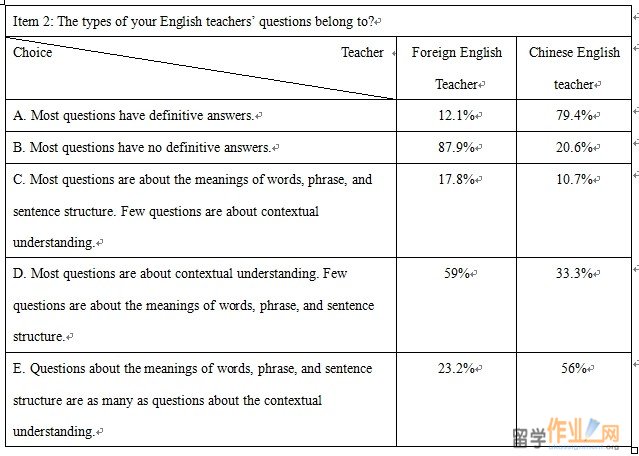 Item 2: The types of your English teachers’ questions belong to? Choice Teacher Foreign English Teacher Chinese English teacher A. Most questions have definitive answers. 12.1% 79.4% B. Most questions have no definitive answers. 87.9% 20.6% C. Most questions are about the meanings of words, phrase, and sentence structure. Few questions are about contextual understanding. 17.8% 10.7% D. Most questions are about contextual understanding. Few questions are about the meanings of words, phrase, and sentence structure. 59% 33.3% E. Questions about the meanings of words, phrase, and sentence structure are as many as questions about the contextual understanding. 23.2% 56% However, from the questionnaire (Table 6), the great majority of students consider most of their foreign English teachers’ questions do not have definitive answers, which means in students’ minds, among their foreign English teachers’ questions, referential questions account more. Overall, in current Chinese teachers’ English classes, display questions occupy the main part. Moreover, they pay more attention to students’ understanding to words, phrase, sentence structure, as well se the context. These questions are effective to exam-oriented education, because once students make mistakes; teachers can correct them in time. But display questions can not enable students to develop their higher thinking. Students’ participation in the class will be greatly reduced, their ability to organize language, and the skills of expressing and communicating are difficult to get trained. So the pragmatic function of language is severely weakened. In contrast, most students believe their foreign English teachers do not place much emphasis on the words, phrases, or sentence structures; instead, foreign English teachers are more likely to emphasize on the context, and to encourage students to express themselves in a creative way. Brock’s (1986) research indicates referential questions can increase learners’ output of language, so as to promote the language acquisition. Nunan’s (1987) study proves that when teachers raise referential questions, the situation of students’ using language becomes more complex, and is closer to the natural environment. Therefore, in order to increase classroom interaction and students’ higher thinking, Chinese English teachers should raise more referential questions which provide students more opportunities to communicate meaningfully.#p#分页标题#e# 4.2.5 Wait time Two kinds of wait-time are proposed by previous researchers: wait time 1 and wait time 2. Wait-time 1 refers to the amount of time teachers allow to wait after they pose a question and before students begin to speak; and wait-time 2 refers to the amount of time a teacher wait after students have stopped speaking and before he/she says anything. Most researches are focused on wait time 1, so does this paper. This period of time teachers wait before students providing the answers is the most active time of students’ thinking, as well as the best period of reorganizing the knowledge structure. Increasing the amount of wait time can help students think more deeply, organize their answers, improve their achievement and decrease their failures to response. Holley & King (1971) suggest at least leaving 5 seconds for students to think and White & Lightbown (1987) recommend 15 seconds. Generally speaking, the wait time should not exceed 20 seconds, otherwise students will have slack tendency. Table 7: Wait Time  Teacher Average Wait Time(s) The Longest Wait Time(s) The Shortest Wait Time(s) Foreign English Teacher 19.4 207 <1s Chinese English Teacher 8.7 220 <1s Table 8: Wait Time 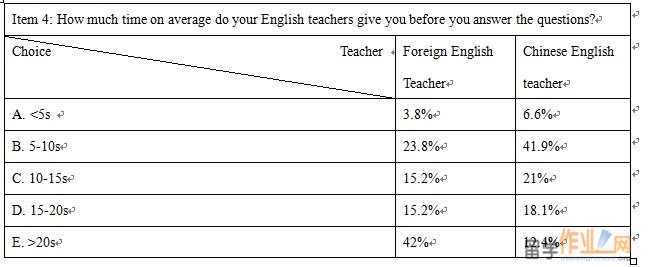 Item 4: How much time on average do your English teachers give you before you answer the questions? Choice Teacher Foreign English Teacher Chinese English teacher A. <5s 3.8% 6.6% B. 5-10s 23.8% 41.9% C. 10-15s 15.2% 21% D. 15-20s 15.2% 18.1% E. >20s 42% 12.4% From the recording material and questionnaire, the statistical results of English teachers’ wait time are shown in Table 7 and Table 8. The average wait time of foreign English teacher is 19.4 seconds, and the average wait time of Chinese English teacher is 8.7 seconds. Although there is no big difference between the longest and the shortest time they wait, on average, foreign English teachers obviously give students more time than Chinese English teachers both from the observation and students’ feeling. The realization of real communication and the creative using of language in classroom are relied on the questions and the answers between teachers and students. Spending too much time on simple questions makes students lose interest in classes, while insufficient thinking time also will lead to misunderstanding or incomprehension. So teachers should arrange the appropriate wait time according to the levels of questions. Through observation, the questions these two teachers wait less than one second belong to the simple true or false type, and students do not need much time to think about it before giving responses. However, the questions they spend the longest time are all referential questions, which need students to think thoroughly, sometimes even need them to discuss with other students so as to provide the best answers. From what we observed, since students have some difficulties in understanding foreign English teachers' discourse, including the questions, foreign English teachers spend much time in explaining their questions, and the class pace automatically becomes relatively slow. However, in Chinese English teachers’ class, students can find answers in the textbook to the large quantity of their questions. As long as well prepared before class, students can give quick responses to the majority of the questions. So the pace of Chinese English teachers’ classes is relatively fast. 4.2.6 Feedback Apart from the above three elements, teachers should also pay essential attention to the feedback. Large numbers of researches indicate the positive feedback is more beneficial to learners than the negative feedback. Instead of the criticism, the praise and encouragement can arouse students’ learning motivation to a larger extent. According to the recording material, the results of these two teachers’ feedback are shown in Table 9. Table 9: The Proportion of the Different Kinds of Feedback Feedback 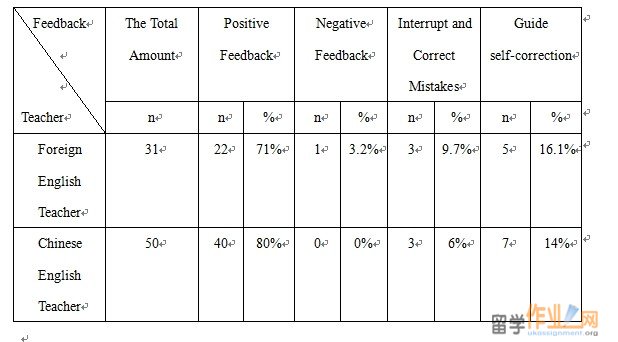 Teacher The Total Amount Positive Feedback Negative Feedback Interrupt and Correct Mistakes Guide self-correction n n % n % n % n % Foreign English Teacher 31 22 71% 1 3.2% 3 9.7% 5 16.1% Chinese English Teacher 50 40 80% 0 0% 3 6% 7 14% Table 10: The Proportion of the Different Kinds of Feedback 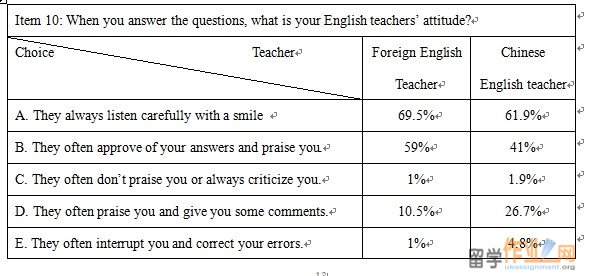 Item 10: When you answer the questions, what is your English teachers’ attitude? Choice Teacher Foreign English Teacher Chinese English teacher A. They always listen carefully with a smile 69.5% 61.9% B. They often approve of your answers and praise you. 59% 41% C. They often don’t praise you or always criticize you. 1% 1.9% D. They often praise you and give you some comments. 10.5% 26.7% E. They often interrupt you and correct your errors. 1% 4.8% F. They often repeat your mistakes and guide you to correct them by yourself when you answer the questions. 3.8% 21.9% G. They often ignore the unimportant mistakes, but explain important mistakes after you complete your answers. 11.4% 33.3% Table 11: The Proportion of the Different Kinds of Feedback 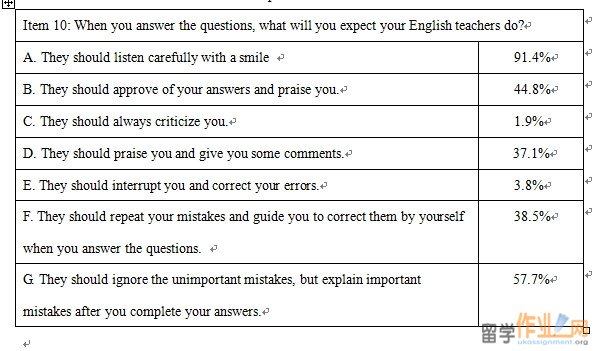 Item 10: When you answer the questions, what will you expect your English teachers do? A. They should listen carefully with a smile 91.4% B. They should approve of your answers and praise you. 44.8% C. They should always criticize you. 1.9% D. They should praise you and give you some comments. 37.1% E. They should interrupt you and correct your errors. 3.8% F. They should repeat your mistakes and guide you to correct them by yourself when you answer the questions. 38.5% G. They should ignore the unimportant mistakes, but explain important mistakes after you complete your answers. 57.7% Table 9 shows that both foreign English teacher and Chinese English teacher give students more positive and effective feedback. Besides the simple praise, sometimes they add comments according to students’ answers. The result of questionnaire is similar to the recording material. Students confirm their teachers’ kindness, and in their minds, teachers often praise rather than criticize them. When dealing with students’ errors, both of Chinese and foreign English teachers seldom correct students’ mistakes when they are speaking. When students are answering the questions, teachers should not interrupt students freely just because of some grammar mistakes or content errors. If doing so, it can easily interfere with their thinking and expression. To correct students’ mistakes will make them into self-defense, and then they will change their attention to the form rather the meaning, so it is not beneficial to the language acquisition and teachers should try to avoid correcting students’ mistakes (Krashen, 1982). However, some scholars hold the different opinion. Schmidt & Frota (1986) consider any learner’s language output is also the output of the whole class. If teachers do not correct the errors immediately, students may think it is right to express in this way, and internalize the errors. How to handle students’ errors can really help language acquisition is need to be further discussed. At least, in our questionnaire, most students think the best way teachers’ dealing with their mistakes is to ignore the small mistakes, and after they complete their answers, teachers could choose the important parts to give explanations.#p#分页标题#e# 5 Conclusion结论 By analyzing the data we get, we find that on one hand, Chinese English teachers and foreign English teachers share something in common: (1) their talking time accounts the most time of a whole class and they spend nearly half of their taking time on questioning. But under comparing, foreign teachers give students more talking time; (2) they adopt the similar feedback strategy, which is giving students more positive response and more encouragement. When dealing with students’ mistakes, both of them seldom interrupt students’ talking. Instead, they ignore the unimportant errors, and correct the big mistakes after students complete answering the questions. On the other hand, there exits some difference between them: (1) Foreign English teachers obviously leave more wait time to students before asking them to give responses; (2) Chinese English teachers raise more questions than foreign English teachers, and the large percent of which belong to referential questions. Moreover, Chinese English teachers pay more attention to the phrase, grammar, and sentence structures, while foreign English teachers focus more on the contextual understanding. Because of the limitation of the observation subject and some objective conditions, the result may not reflect all the actual conditions of all Senior English classes. However, at least, we can discover that in English classes, there are still many points of questioning strategies need to be noted and to be improved. Therefore, we should attach great importance to English teachers’ questioning strategies. Based on what we discover, we propose that both Chinese English teachers and foreign English teachers should make a systematic arrangement of the quantity of referential questions and display questions, give students appropriate thinking time, and encourage them to express their views bravely. Besides, they also need to give students the cognitive feedback and emotional support in order to make them engaged in the class more actively. |
 |
|||
| 网站地图 |

